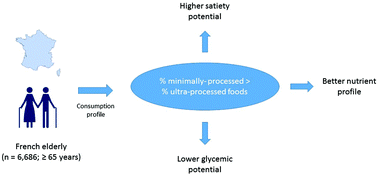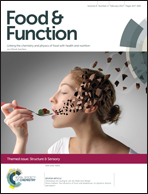The degree of processing of foods which are most widely consumed by the French elderly population is associated with satiety and glycemic potentials and nutrient profiles†
Abstract
Food processing impacts both food structure and nutritional density. The effect of food structure on satiety and glycemic potentials is well recognized. However, the association between processing, satiety and glycemic potentials and nutrient profiles has not been much studied, especially in the diets of the elderly. Therefore, this study aimed at exploring relations between the level of food processing, consumption and nutrient profiles and satiety and glycemic potentials among 6686 French elderly people (≥65 years). Dietary assessment was realized through a web-based 24 h dietary record tool. Among a total of 2688 foods, 280 generic foods were aggregated based on a consumption threshold of at least 5% by the population. The satiety potential was calculated using the Fullness Factor equation, and the glycemic potential using the glycemic index and the glucose glycemic equivalent. Foods and dishes were ranked according to an adapted international NOVA classification as raw/minimally-processed (G1), processed (G2) and ultra-processed (G3). ANOVA and correlation analyses showed that the more food is processed, the lower its satiety potential and nutrient density and the higher its glycemic impact, especially when comparing G1 and G3. Besides, the foods consumed in the greatest quantity daily tend to be the most satiating, and ultra-processed foods were among the less frequently consumed both in terms of percentage and daily quantity (around two-fold difference between minimally- and ultra-processed foods). In conclusion, because it is partly related to health food potential, the degree of processing, especially for ultra-processed products, should be taken into consideration more when evaluating consumption profiles of different populations.



 Please wait while we load your content...
Please wait while we load your content...